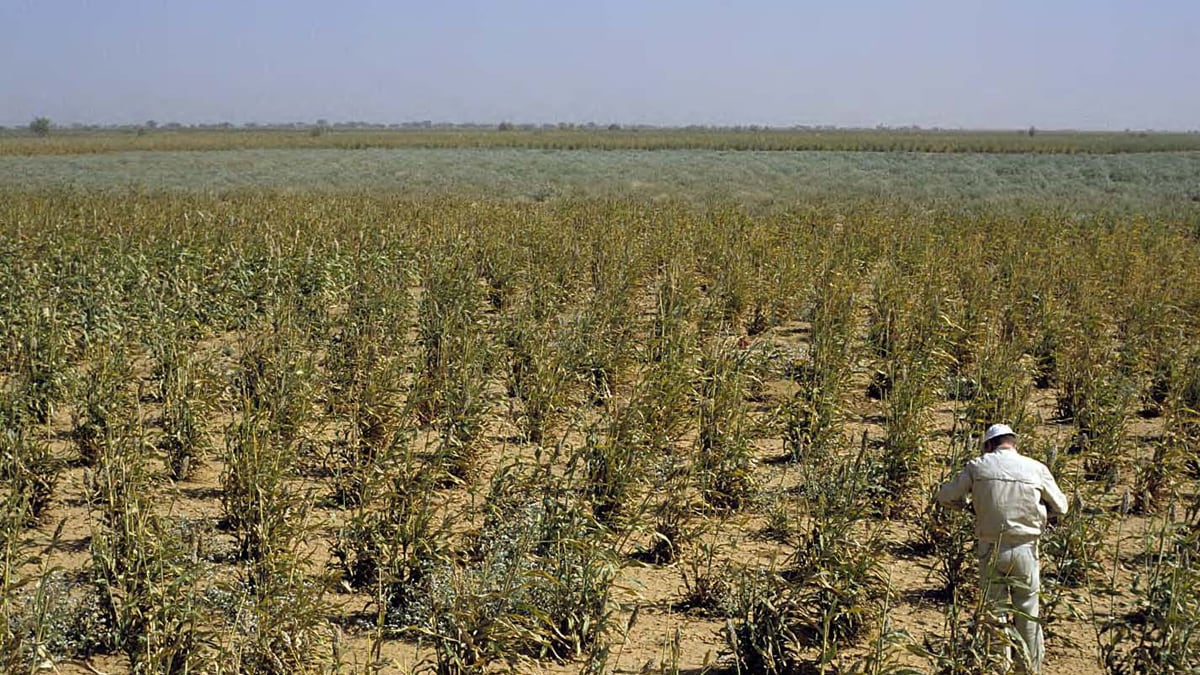A few thousand years ago, a mighty river flowed through the Sahara across what is today Sudan. The Wadi Howar—now just a dried-out riverbed for most of the year—sustained not just fish, crocodiles, and hippopotamuses, but also agriculture and human settlement. As late as 1,000 B.C., a powerful fortress stood on its shores. But then the Sahara dried out, turning from a green savannah into an inhospitable desert. The culprit: climate change. According to desert geologist Stefan Kröpelin, who has studied geological data for the eastern Sahara going back 6,000 years, the desert spread as temperatures dropped. Global cooling meant that the air had less capacity to hold moisture from the oceans, leading to fewer rains and more arid climes.
Now, that same process is happening in reverse. As temperatures rise, the Sahara and other dry areas are greening on the edges. “I’ve been studying the Sahara for 30 years and can definitely say that it’s getting greener,” says Kröpelin, who specializes in desert archaeology and climate history at the University of Cologne. Where there used to be nothing but desert, he says, there is now not just grass but shrubs and acacia trees--and he has the photos from 30 years of extensive field study to prove it. “The nomads are taking their camels to graze in areas where they’ve never been able to graze before.” Satellite data showing more green on the southern edge of the Sahara also bear him out. "There are always winners and losers if weather patterns change," he says. “But as a general rule, warmer temperatures inevitably mean that the air picks up more moisture from the oceans, which will lead to more rainfall. If you look at the geological records in the Sahara, there have been repeated periods where the Sahara was greener when temperatures were warmer than today.”
Kröpelin’s geological data seem to question the popular notion that climate change will bring negative, if not outright apocalyptic effects: A dying Amazon, failing rains, drought, and desertification. The latest IPCC report predicts a decline in rainfall across large swaths of Africa of 20 percent or more, leading to deadly famines like the one raging in Somalia now. Millions of “climate refugees” might one day roam the earth.
Kröpelin is not the only scientist chipping away at these scenarios. An increasingly rich trove of data suggest that in large parts of the world, the more likely outcome is that warmer temperatures lead to more rainfall, richer plant growth, and the re-greening of areas that have been inhospitable for many centuries.

Farming is expanding again in frosty Greenland, which got its name because farming was possible when the Vikings first settled there during the “Medieval Warm Period,” a previous phase of global warming. In the Alps, the tree line--meaning the altitude above which trees no longer grow because of the cold and wind--has been steadily rising, with forests growing thicker, according to researchers at the Swiss Institute for Forest, Snow and Avalanche Research in Davos. In arid Namibia, stuck between the Namib and the Kalahari Deserts, farmers say the last decade has seen increased rainfall, higher grass, and more of the wildlife that feeds on it.
In the latest issue of Nature, a U.S. Department of Agriculture study discovered that the higher temperatures and CO2 levels forecast by the IPCC boost the growth of prairie grass, a surprising find that suggests a greener, more fertile future for the world’s semi-arid grasslands, which cover one-third of the global land mass.
Widely reported scenarios that higher temperatures will dry out the Amazon rain forest also seem to be contradicted by evidence assembled by Smithsonian researcher Carlos Jamarillo. Jamarillo has studied the fossilized remains of ancient rainforests and concludes that warmer temperatures went hand-in-hand with greater plant growth and higher species diversity. It was the opposite of what the researchers expected.
So why do we invariably connect higher temperatures with droughts and desertification? The problems of the famine-prone Sahel zone--the dry belt running across Africa on the southern edge of the Sahara--seem to have much less to do with weather than the fact that the population has roughly tripled since the 1950s, and with the arrival of millions of goats with their destructive grazing habits (unlike native camels or gazelles, goats rip out the entire plant, roots and all, killing vegetation wherever they go). Areas that have been fenced to keep out the goats, says Kröpelin, have seen vegetation rebound, and are greener than ever before. The Sahel has been degraded by human use, not natural desertification; the natural process has been the reverse.
Kropelin says he’s been criticized by some fellow scientists who accuse him of spreading optimistic views that run counter to mainstream climate scenarios. “I keep telling anyone who will listen, come to the desert and see for yourselves,” says Kröpelin. “But they’re too busy with their computer models and don't seem to be very interested in what’s going on in the field.” If Kröpelin and his fellow geologists, botanists, and biologists are right, then a warmer planet might not be quite as bad as we’ve been taught to fear.






